In this article, we explore 20 ideal freshwater aquarium plants for beginners. These plants are easy to care for and adaptable, enhancing the aquarium’s beauty and providing benefits like filtration and oxygenation. They create a natural habitat for fish and are almost impossible to kill, thriving in various water conditions. The guide is an invaluable resource for new aquarists aiming to create a vibrant, healthy aquatic environment.
If you’ve never looked at a planted tank before, you’d probably be surprised at just how vibrant and lively the aquarium seems to be. That’s because the freshwater aquarium plants provide natural filtration for the water, help keep fish healthy, and can even help you breed your fish. Aquarium plants are used by fish for any number of things. They are used for safety, comfort, food, and reproduction. So, they’re vital to any healthy aquarium environment. You’ll find great resources in a few places online. But, here’s a list of the top 20 freshwater aquarium plants that are nearly impossible to kill, and grow quickly in almost every kind of water.
Table of Contents
20 Best Freshwater Aquarium Plants
1. Java Moss
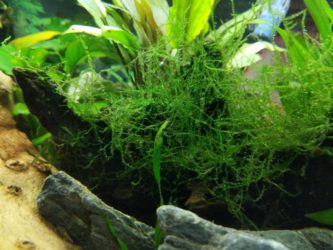
Java moss is a prevalent moss that grows naturally on rocks and trees in tropical climate zones. It lacks roots, meaning that the moss can float through the water to gain any nutrients it needs.
However, it will also attach itself to aquarium décor or substrate. Java moss is characterized by its tiny oval-shaped leaves, helpful in obscuring unattractive aquarium equipment such as filters.
The moss will easily adhere to any porous surface, making it perfect for décor. Just know that it can get out of hand if not kept well-groomed; other aquatic moss species like Christmas Moss may suit your needs better if you prefer something tidier.
|
Scientific Name |
Vesicularia Dubyana |
|
Family |
Hypnaceae |
|
Care Level |
Beginner |
|
Max Size |
3-10 inches long |
|
Color |
Light green |
|
Temperature |
59 – 82°F |
|
Hardness |
Up to 20 dGH |
|
pH |
5.0 to 8.0 |
2. Dwarf Baby Tears
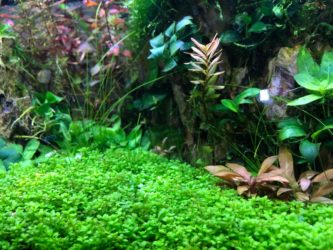
Dwarf Baby Tears are very delicate and attractive foreground plants available today. Their colorful clusters can be utilized to entirely cover the substrate in freshwater aquariums, creating a soft bed of rich green or for covering floating on the water’s surface. They need a lot of lightning and nutrients, so getting them to establish in your aquarium fully can be challenging, but they shouldn’t have any difficulties developing once they do.
Dwarf baby tears were identified in the area east of Havana, Cuba, for the first time. Other members of the Hemianthusgenus, on the other hand, maybe found in other nations.
While little is known about this species’ natural freshwater habitat, it is assumed to originate in shallow waters with high nutrient content and a moderate to fast water current. It prefers to hide between rocks and fallen trees, attaching itself with its roots in porous surfaces.
|
Scientific Name |
Hemianthus callitrichoides |
|
Family |
Linderniaceae |
|
Care Level |
Moderately Difficult |
|
Max Size |
5-6 inches |
|
Color |
Bright Green |
|
Temperature |
68-82° F |
|
Hardness |
4 and 5 dGH |
|
pH |
5.0-7.5 |
3. Dwarf Hairgrass
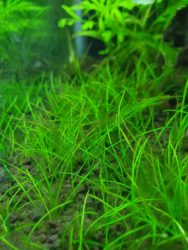
These species can be located worldwide, from North America to Europe, and even as far as Asia and South America. It can be found in shallow freshwaters where there is plenty of light.
Dwarf Hairgrass is commonly utilized as a carpet, covering the tank’s bottom in a lush green carpet. Because it’s a fast-growing plant, you can get this effect with a small amount that quickly grows.
This carpet protects bottom-dwelling species while also oxygenating and cleaning the aquarium. It’s popular in the fishkeeping industry because it’s a low-maintenance aquatic plant. It has only the most basic requirements, requiring only light, nutrients, and CO2. It’s straightforward to maintain, so even beginners can do it without spending too much time on it.
| Scientific Name | Eleocharis parvula & Eleocharis acicularis |
| Family | |
| Care Level | Easy |
| Max Size | 6 inches |
| Color | Green |
| Temperature | 50-85°F |
| Hardness | 2-10 dGH |
| pH | 6.5-7.5 pH |
4. Marsilea Minuta
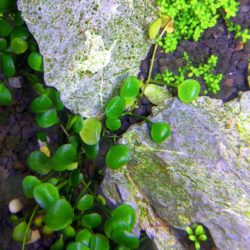
Marsilea Hirsuta is an attractive ground-cover plant because of its powerful carpeting ability. It grows slowly, stays compact at only a few centimeters/inches tall, and spreads its prolific runners all over the place to make thick, attractive carpets. Marsilea Hirsuta is ideal for novices because it can flourish in low light and does not require CO2. Marsilea Hirsuta is found primarily in marshes, ponds, and floodplains throughout Australia. It can grow partially or submerged in shallow, standing waters in sandy or clayey substrates as an aquatic plant. In recent years, the plant has been introduced to portions of Europe and North America.
|
Scientific Name |
Marsilea Hirsuta |
|
Family |
Marsileaceae |
|
Care Level |
Easy to Medium |
|
Max Size |
Up to 4 inches |
|
Color |
Green |
|
Temperature |
68 – 77°F |
|
Hardness |
2 – 12 dGH |
|
pH |
6.0 – 7.5 |
5. Amazon Sword
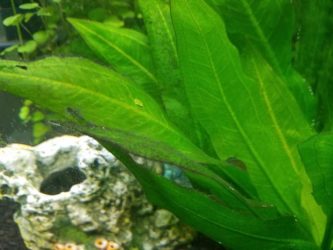
The Amazon Sword Plant is an aquatic plant that has gained popularity among fish keepers worldwide in recent years. It comes from the Amazon River Basin, which is both diverse and attractive. Many aquarists call the Echinodorus grisebachii or Echinodorus Amazonicus the actual Amazon Sword Plant because they are the same plant.
Even though several plants are offered as Amazon Sword Plants, this isn’t a problem because they all require the same tank conditions and care. Plants of the genus Echinodorus can also be found in the United States, Cuba, and Columbia. However, the majority of the plants grow in the Amazon River basin, which has its flora and fauna.
|
Scientific Name |
Echinodorus Grisebachii |
|
Family |
Alismataceae |
|
Care Level |
Easy |
|
Max Size |
16 Inches |
|
Color |
Green |
|
Temperature |
60.8-82.4°F |
|
Hardness |
8-15 dGH |
|
pH |
6.5-7.5 |
6. Java Fern
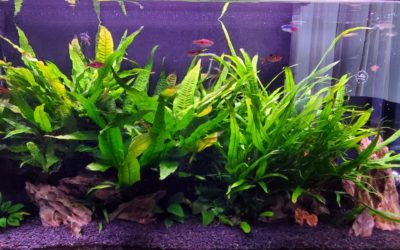
This delicate-looking fern gives aquariums a lovely appearance. It’s popular because of its sluggish growth, distinctive shape, and simplicity of propagation and care. It may be kept with a wide variety of species and does not require stringent water requirements. Hence, so many people find it interesting. Beginners will find them to be one of the easiest plants to grow. It is a jungle plant that grows on rocks, the ground, and around tree trunks along the waterline of streams and waterfalls. It is native to Southeast Asia. It, like grass, flourishes in tropical rainforests. It can grow fully immersed as well as half submerged. Java Fern has been around for a long time, and new types have been evolved. Narrow-leaf, Needle Leaf, Trident, and Windelov are the most common varieties found in fish stores.
|
Scientific Name |
Microsorum Pteropus |
|
Family |
Polypodiaceae |
|
Care Level |
Easy |
|
Max Size |
13.5 inches |
|
Color |
Green |
|
Temperature |
68-82°F |
|
Hardness |
3-8 dGH |
|
pH |
6.0-7.5 |
7. Anubias Nana
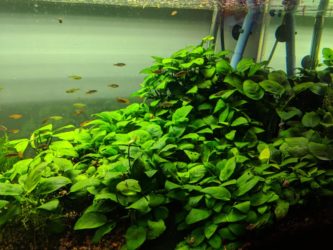
Anubias nana is a small, broad-leaved plant. Many aquarium plants originate in Asia, but this species is endemic to Africa. It is a lovely plant with dark green colors that will assist keep your tank water clean and oxygenated. For beginners, adding plants to an aquarium can be intimidating because it adds another thing to take care of. The excellent news is that this plant is quite resilient and can withstand most rookie blunders. Because it grows slowly, you won’t have to put much effort into keeping it up, just a trim now and then. It’s also simple to disseminate, so you may start small and gradually expand it across your tank.
|
Scientific Name |
Anubias barteri var. nana |
|
Family |
Araceae |
|
Care Level |
Easy |
|
Max Size |
7.5 inches |
|
Color |
Green |
|
Temperature |
72-82°F |
|
Hardness |
3-8 dGH |
|
pH |
6-7.5 |
8. Pygmy Chain Sword
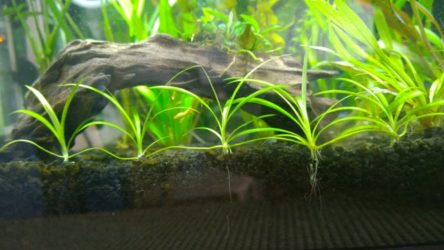
This Chain Sword cultivar is praised for its hardiness, durability, rapid growth, and ease of maintenance. The Pygmy chain sword is an excellent choice for novices because it is simple to grow. They need little care. They can also live without CO2. Pygmy chain swords are found throughout the Americas, including Texas, Michigan, Florida, and Missouri in North America and Central and South America. In marshes, ponds, streams, and other water areas, it grows fully or partially submerged
|
Scientific Name |
Echinodorus Tenellum |
|
Family |
Alismataceae |
|
Care Level |
Easy |
|
Max Size |
4 inches |
|
Color |
Green |
|
Temperature |
72 to 80°F |
|
Hardness |
3-10dGH |
|
pH |
6.5 – 7.5 |
9. Pogostemon Helferi
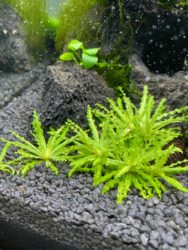
Besides having an interesting name, Pogostemon helferi is one of the unique foreground plants available to aquarium keepers today. It has a striking zig-zag shape in its leaves and grows in a ‘blooming’ pattern that’s visually appealing in front of hardscapes.
|
Scientific Name |
Pogostemon helferi |
|
Family |
Mints |
|
Care Level |
Easy |
|
Max Size |
2-6 inches |
|
Color |
Green |
|
Temperature |
68-86 °F |
|
Hardness |
7-8 dGH |
|
pH |
6-7.5 |
10. Dwarf Sagittaria
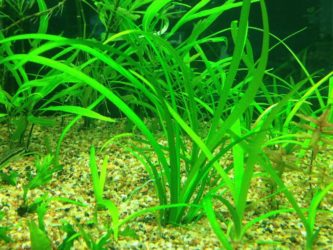
Dwarf Saggitaria is a low-maintenance plant that grows to a maximum height of 4-6 inches, making it ideal for midground aquascapes. Dwarf Saggitaria is a fantastic companion to stonework or driftwood. This is because it provides a perfect area for it to root into the wood or stone.
|
Scientific Name |
Sagittaria subulata |
|
Family |
Alismataceae |
|
Care Level |
Easy |
|
Max Size |
4-6 inches |
|
Color |
Green |
|
Temperature |
68 to 82 °F |
|
Hardness |
2-15 dGH |
|
pH |
6.0 – 8.0 |
11. Green Hygro
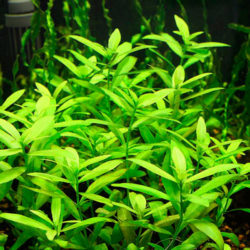
Green Hygro is a fast-growing stem plant with long leaves that can range from green to brown to red, depending on the sunlight. Because this plant requires a sizable substrate to anchor its roots, choose a decent planted aquarium substrate. Low illumination should be used to avoid browning. Green Hygro is classified as a weed in some states. It is restricted in others due to its rapid growth. Before purchasing the Green Hygro for your aquarium, make sure you check your local laws. The Green Hygro is a prolific plant that can get out of hand if it’s in love with a particular arrangement. CO2 boosts can also help, but they aren’t required.
|
Scientific Name |
Hygrophila polysperma |
|
Family |
Acanthaceae |
|
Care Level |
Easy |
|
Max Size |
24 Inch |
|
Color |
Green/Red |
|
Temperature |
64–86 °F |
|
Hardness |
2-15 dGH |
|
pH |
5-8 pH |
11. Sunset Hygro
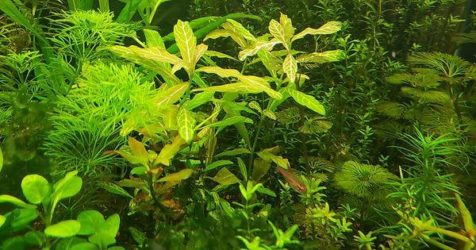
The Sunset Hygro is a close relative of the Green Hygro. It comes with the hue of the leaves being the main distinction. The leaves of the Sunset Hygro are red-pink with white veins. Like the Green Hygro, it needs to be pruned frequently. Pruning can be done with pruning shears or by pinching off new growth by hand. In addition, the water must have adequate iron levels to preserve the vibrant red hues of its leaves. In a low-light aquarium, both red and green variants make excellent indicator plants. They tend to shed their leaves when nutrition levels or other difficulties occur, signaling a concern.
|
Scientific Name |
Hygrophila polysperma |
|
Family |
Acanthaceae |
|
Care Level |
Easy |
|
Max Size |
Up to 16 inches. |
|
Color |
Green |
|
Temperature |
62–84 °F |
|
Hardness |
71.43 to 321.43 dGH |
|
pH |
6.3 to 7.5 |
12. Rotala Rotundifolia
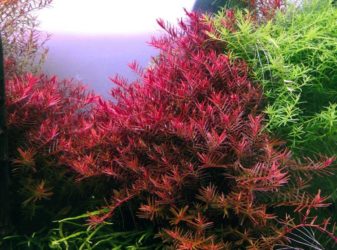
The Rotala Rotundifolia is a well-known aquarium plant with a pink hue and narrow rounded leaves. They cascade downward in a bushy growth pattern when allowed to grow to the water’s surface. This plant is another example of a fast-growing plant that necessitates optimum lighting for optimal color. It, like Hygros, needs to be pruned frequently to avoid overgrowth. Rotalas rarely grow wider than 6 inches, but they will continue to grow vertically and climb the aquarium’s sides.
|
Scientific Name |
Rotala rotundifolia |
|
Family |
Lythraceae |
|
Care Level |
Easy |
|
Max Size |
Up to 6 inches |
|
Color |
Green with Pink Hues |
|
Temperature |
62-82°F |
|
Hardness |
4.0 to 8.0 |
|
pH |
2 – 12 dGH |
13. Hornwort
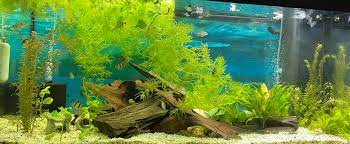
Hornwort gets its name from its distinctive leaves design, which has earned it the nickname “Coontail.” The leaves spread outwards in a tangle of stems, resembling a bushy tail. The hornwort is a brilliant green plant that does not require a stable substrate because it lacks genuine roots. It will attach itself to aquarium objects or float freely in the water. Hornwort proliferates and makes an excellent nursery for young fish.
|
Scientific Name |
Anthocerotophyta |
|
Family |
Ceratophyllaceae |
|
Care Level |
Easy |
|
Max Size |
120 inches |
|
Color |
Green |
|
Temperature |
59-86°F |
|
Hardness |
5-15 dGH |
|
pH |
6.0-7.5 |
14. Moneywort
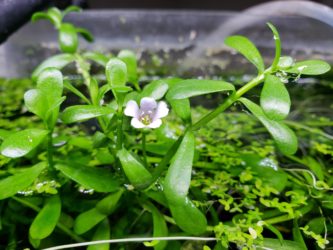
Moneywort is a spreading plant with various names that are widely used to add color to aquariums. The moneywort has small, brilliant green oblong leaves that grow upwards along robust stems. Moneywort shoots are frequently planted close together to create contrast with other plants. Moneywort grows vertically, touching heights of 6-8 inches.
|
Scientific Name |
Hydrocotyle ranunculoides |
|
Family |
Araliaceae |
|
Care Level |
Easy |
|
Max Size |
6-8 inches |
|
Color |
Green |
|
Temperature |
68 – 82°F |
|
Hardness |
4 – 18 dGH |
|
pH |
6.8 – 7.2 |
15. Guppy Grass
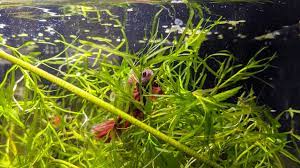
The term “guppy grass” is used as a “nursery” plant for infant guppies. It grows in dense clumps with thin green leaves. This plant will grow steadily and float in the tank. Guppy Grass is difficult to beat in terms of versatility. The plant will grow in any aquarium, whether you want to root it, let it float, or utilize low or high light.
|
Scientific Name |
Najas guadalupensis |
|
Family |
Hydrocharitaceae |
|
Care Level |
Easy |
|
Max Size |
Up to 90 cm |
|
Color |
Green |
|
Temperature |
68 – 79 °F |
|
Hardness |
2 – 20 dGH |
|
pH |
6.0 – 8.0 |
16. Pelia Moss
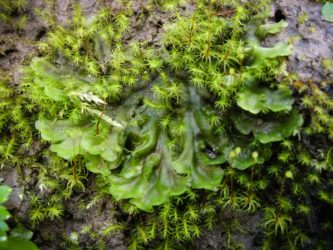
Pelia is a unique plant that serves different needs than most mosses, despite its resemblance to moss. Pelia, unlike moss, does not adhere to structures and spreads quickly in thick mats. Pelia sinks naturally and can float free or fastened down with a netting or fishing line. Pelia is a popular choice for aquariums because of the distinctive structure of its shoots.
|
Scientific Name |
Monosolenium tenerum |
|
Family |
Urticaceae |
|
Care Level |
Easy |
|
Max Size |
2-5 cm |
|
Color |
Green |
|
Temperature |
65° – 77° F |
|
Hardness |
3-12 dGH |
|
pH |
5.0 – 7.5 |
17. Bacopa
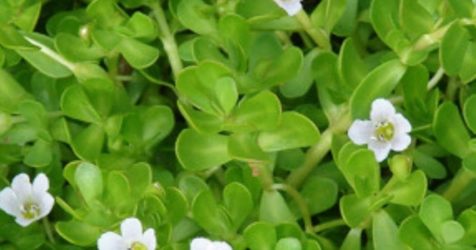
The Bacopa is a well-known aquatic plant with oblong leaves that grow opposite each other, producing a “ladder” up each stalk. The color of the Bacopa varies from brilliant greenish-yellow to brown. It requires an adequate substrate to take root. It is a slow-growing plant.
|
Scientific Name |
Bacopa caroliniana |
|
Family |
Plantaginaceae |
|
Care Level |
Easy |
|
Max Size |
12 inches |
|
Color |
Green |
|
Temperature |
58 – 90° F |
|
Hardness |
5 – 20 dGH |
|
pH |
5.0 -9.0 |
18. American Waterweed
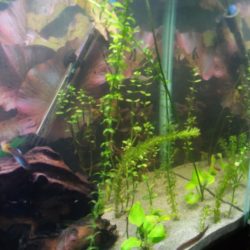
Elodea is a fast-growing, long-stemmed plant that can be floated or rooted in the substrate and provides enough cover for little fish. In North America, the elodea can be found growing wild in ponds and lakes. Many aquatic species, such as ducks, turtles, beavers, and others, eat it. However, because it is considered an invasive species in some states, it is necessary to check local rules before adding it to an aquarium. Elodea is a favorite of vegetarian fish because of its velvety leaves and rapid development.
|
Scientific Name |
Elodea canadensis |
|
Family |
Hydrocharitaceae |
|
Care Level |
Easy |
|
Max Size |
3 m or more |
|
Color |
Green |
|
Temperature |
60-82°F |
|
Hardness |
3-8 dGH |
|
pH |
6.5-7.5 |
19. Micro Crypt
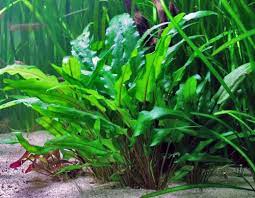
Like the crypts mentioned above, the micro crypt is a slow-growing plant with thin, long leaves with ruffled edges. The micro crypt is the tiniest of the crypt kinds, reaching only a few inches in height when fully grown. C. Petchii, like other dwarf crypts, prefers fast-flowing, shaded streams in Sri Lanka. It’s a slow-growing plant that’s also hardy and low-maintenance. Many crypts are available in pet stores as bulbs. This enables you to build a robust root system for your new plants over time!
|
Scientific Name |
Cryptocoryne Beckettii. Thwaites ex |
|
Family |
Araceae |
|
Care Level |
Easy |
|
Max Size |
2-4 inches |
|
Color |
Green |
|
Temperature |
59-82°F |
|
Hardness |
1 – 18 dGH |
|
pH |
6-7.5 |
20. Marimo Ball
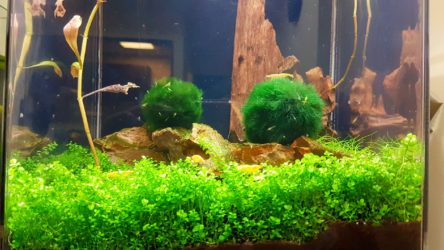
The Marimo is commonly mistaken for moss. It is a spherical algae strain that grows outward radially, naturally producing a ball shape. These low-light aquarium plants grow slowly but are extremely easy to maintain and live a long time. They’re popular because of their distinct appearance, and they’re frequently utilized as décor. Marimo Moss Balls need a slight current to stay in form. They may flatten out over time in low-light aquariums without powerheads or vigorous filtration. They also love chilly, clear water, much like the pristine ponds from which they came. Overfertilization can be fatal to these delicate aquatic plants.
|
Scientific Name |
Aegagropila linnaei |
|
Family |
Cladophoraceae |
|
Care Level |
Easy |
|
Max Size |
1.75 to 2.25 inches in diameter |
|
Color |
Green |
|
Temperature |
72-78°F |
|
Hardness |
2 to 20 dGH |
|
pH |
6.0-8.0 |
Frequently Asked Questions (FAQs)
Why Do You Want Aquarium Plants?
Aquarium Plants are not only beautiful, but they also have numerous chemical and physical benefits. When it comes to a thriving, healthy aquarium, aquarium Plants are crucial. Both rookie and experienced aquarium hobbyists will benefit from Aquatic Plants.
What are the Different Types of Aquarium Plants?
1. Foreground plants
Aquatic plants positioned near the midground portion of a hardscape layout are known as foreground aquarium plants. Carpeting plants are a term used to describe foreground aquarium plants.
2. Mid-ground plants
Aquarium plants in the midground are the “average” plants in the aquarium world. They are too short for the back of the tank, but they are also too tall for the front. As a result, they must be placed in the center.
3. Background plants
Background plants are excellent for filling in considerable areas in the back of your aquarium. They’re also great for hiding unsightly equipment like heaters and filters. Because many of them grow swiftly, they will need to be pruned frequently.
What is an aquarium substrate?
Substrate refers to the material used on the tank’s bottom. It impacts the aquarium’s water chemistry, filtration, and the well-being of its residents, as well as being a vital aspect of the aquarium’s aesthetic appeal.
If you’ve enjoyed reading this post and find it useful, please do me a favor by sharing it with your friends. For more aquarium guides and inspiration, do sign up to our newsletter or like our FB Page.
No related posts.

37 thoughts on “Top 20 Best Freshwater Aquarium Plants for Beginners (2025)”
Hi!
Thank you for such a lovely article. I’m a beginner & It’d be really helpful if you could also mention the various prerequisites for each plant & the type of fish that can be placed in the aquarium.
Warm regards,
Ash
If you’re a beginner don’t try to use Hemianthus callitrichoides “dwarf baby tears” or POGOSTEMON HELFERI “downoi”. These not beginner plants at all. If your a beginner and not very good with plants in general, stick with ferns, moss, and anubis, and never bury them. Instead tie them to rocks or wood.
How do you tie them to rocks? We are planting everything in the substrate, and I am really struggling with my java moss! Haha! Do you use thread to bunch it together and tie to something? Sorry, no idea!! Thanks!
Hi, you need to tie the java moss to something preferably a rock or driftwood to make sure it stays in position. You can use a fishing line or even thread.
Hello, This may be a bit old news at this point by the looks of the date posted but I have had great success using Aqua-glue for adhering my Java Moss to rocks and driftwood. This stuff is like underwater super glue and is very inexpensive. The brand that I use is made by Seachem and is called Flourish Glue. It does not hurt any other components in your aquarium and is perfectly fish-safe.
Regards,
JZ
Might want to switch to Gorilla Super glue gel if the other is expensive, I use Gorilla super glue gel in my reef tank and it works awesome, and doesn’t harm anything, and if you know anything at all about corals and reefs, they are extremely sensitive to water changes and stuff sometimes, but it doesn’t bother the coral or the fish, I know this is an old thread, but just a bit of info
It is awesome!
java moss, java fern and anubias nana are good plants for a starter aquarium? will they get along nice with all kinds of fishes?
if not, what are the best fresh water plants (low maintenance and fish friendly) for a starter?
thanks in advance.
Hi Marco, yup they are fairly easy to maintain especially Anubias Nana. They’ll get along fine with most fishes.
thanks adam. just gotta find theyr names in portuguese and look for a store in portugal that has it….. not easy, things here got very expensive in the last decade and many aquariofilia stores closed down 🙁
buying online, it gets very expensive to ship out i bet…..
Yup it gets pretty expensive unless you are able to find a domestic online shop. Another way is you could look for others within your area who might be willing to sell their excess. A good place to start would be Reddit – AquaSwap
portuguese folks arent used to reddit, might have better luck among facebook groups. or classifieds websites.
My java moss died instantly even though i have good lighting and plant growth chemicals (for freshwater plants). so I honestly don’t recommend it for beginners, but java fern is a definite yes. I’ve found that you can plant it, tie it or let it float freely in the tank:)
I agree with you. I made 3 attempts and fail misery. It never did at all.
It depends on where you bought your java moss.I had the same experience when I bought it from a online store. It died in days. Then I went to a store who informed me that most online Moss is not used to totally submersed environment. So I tried his and it was true. Very healthy still.
Hello! Marimo moss balls are typically sold in the betta fish section at mainstream petstores. (petsmart petco ect.) Low lighting is what they require; and main care is just squeezing them out every week or so. Note that goldfish may see them as a tasty snack. With freshwater shrimp, moss can help with breeding and overall survival. Hope this helps!
I have a question, can you put bamboo in your aquarium? Also is it better to use the bamboo with Bettas? I have in my 20 gallon aquarium guppies, neon & angel fish. I have my betta in a 5 gallon aquarium.
Hi Shawna, bamboos are not an aquatic plant so it might rot and die if added to your aquarium fully submerge. You might have seen some aquariums with bamboos, those are typically fake bamboos for aesthetic purposes. Hope that helps.
I assume you mean lucky bamboo and not actual bamboo. Lucky bamboo can be planted with the leaves out of water. If planted with the leaves in water it’ll rot.
I want to know if i place a CO2 inside my fishtank, my weeds will grow as they needed however would that harm/effect my fishes? (arvana, Goldfish etc.)
Hi Suraj, generally it will not harm your fishes if you setup your Co2 system properly and introduce a small amount at a time into your tank. It will lead to Co2 poisoning if there are too much Co2 in the tank.
Here’s a good resource to find out more about Co2 poisoning:
http://www.plantedtank.net/forums/8-general-planted-tank-discussion/109806-common-signs-co2-toxicity-fish.html
I want to know whether fresh water planted tank can be closed or not in top with doom?
Hi Varma,
Yes, they can be closed. In fact, there are a number of reasons you should close it. Some of it being prevent heat from escaping, less evaporation and fish can’t jump out.
I have started a 55g heavily planted aquarium, in the past I used once plant food for my 39g and my Panda Cories died within 3 days. My question. Has anyone have this problem? I’d like to give my plants a boost but I’m afraid. By the way, my perimeters were normal when this occurred. Thanks.
Yes, I have. I made a few attempts and fail. My water parameter were fine. Fertilizer and root tab are no use. It is CO2 that works very well but you might end killing your fish.
You don’t need fertilizer. Your healthy fish produce it. I started keeping freshwater tropical fish at around the first grade–with no pump or filter, just very good instruction from my dad. Lots of plants, a few fish. You have to set up the tank for a while before you add fish, then start adding fish very slowly once the plants start growing over most of the tank floor. The fish have lots of safe space and the plants get the best fertilizer possible. It takes patience but the result is very beautiful.
Hi! I just want to ask if there are any aquarium plants that do not need Co2?
Hi Cholo, all plants require Co2. But I’m sure you know that. =p I guess you meant if any plants do not require Co2 injection. Well, having Co2 injection will help All plants grow faster and healthier. But hardy plants like Amazon sword and java moss can survive (but slow growth) without additional Co2 injected into the water.
Hope that helps!
Why will plants not grow under my filter? I have a 36 gal. bow front aquarium & plants grow everywhere else but there.
Can you put sweet pea flowers in an aquarium?
i am a beginner and have a 36 gal set up with sands only without plant growth substrate… what are the freshwater plants recommended? do i need to add a layer of plant growth substrate underneath the sands?
I have a aquarium, I’m a beginner on this field. Is there any plants that can live using the tap water without putting any vitamins or any chemicals on the water to make it alive Thank you
What type of plants are best for guppies? I would like them to stay near the top ? ?
Do you recommend any plants for a beginner with 6 to 10 gloFish (Danio Rerio) in a 20 gal high tank (fluorescent lamp, dark bed)? I want my aquarium to be more than an LED lit plastic farm… something more sustainable and balanced. Perhaps a java fern? Thx in adv.
Sounds like a fun tank! Java fern would look great with a dark substrate and glow fish. Another plant you could use is the dwarf hair grass for carpeting, it looks really nice with dark substrate and brightly colored fish.
how many marimo moss balls should I put in a 10g aquarium and how many in a 5g?
but how to keep these plants healthy for a long time? please suggest.